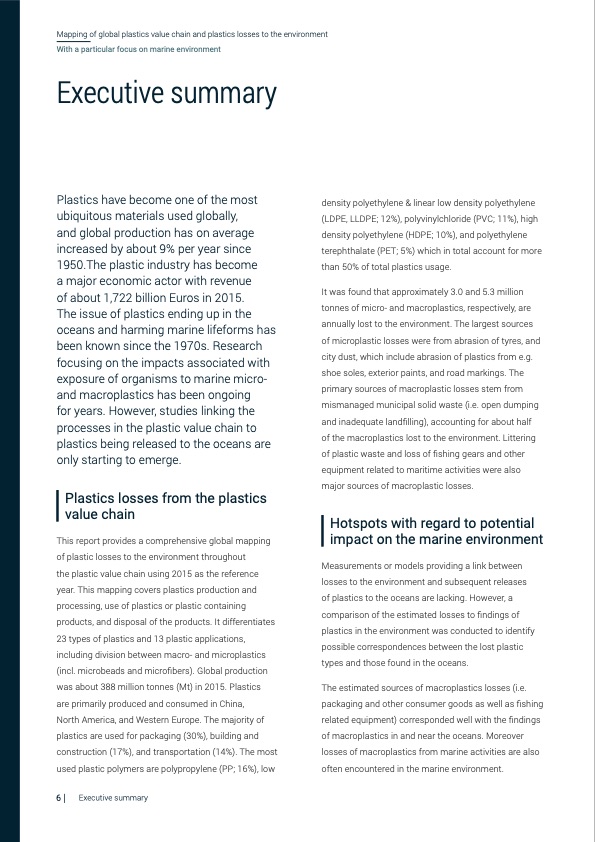
PDF Publication Title:
Text from PDF Page: 008
Mapping of global plastics value chain and plastics losses to the environment With a particular focus on marine environment Executive summary Plastics have become one of the most ubiquitous materials used globally, and global production has on average increased by about 9% per year since 1950.The plastic industry has become a major economic actor with revenue of about 1,722 billion Euros in 2015. The issue of plastics ending up in the oceans and harming marine lifeforms has been known since the 1970s. Research focusing on the impacts associated with exposure of organisms to marine micro- and macroplastics has been ongoing for years. However, studies linking the processes in the plastic value chain to plastics being released to the oceans are only starting to emerge. | Plastics losses from the plastics value chain This report provides a comprehensive global mapping of plastic losses to the environment throughout the plastic value chain using 2015 as the reference year. This mapping covers plastics production and processing, use of plastics or plastic containing products, and disposal of the products. It differentiates 23 types of plastics and 13 plastic applications, including division between macro- and microplastics (incl. microbeads and microfibers). Global production was about 388 million tonnes (Mt) in 2015. Plastics are primarily produced and consumed in China, North America, and Western Europe. The majority of plastics are used for packaging (30%), building and construction (17%), and transportation (14%). The most used plastic polymers are polypropylene (PP; 16%), low density polyethylene & linear low density polyethylene (LDPE, LLDPE; 12%), polyvinylchloride (PVC; 11%), high density polyethylene (HDPE; 10%), and polyethylene terephthalate (PET; 5%) which in total account for more than 50% of total plastics usage. It was found that approximately 3.0 and 5.3 million tonnes of micro- and macroplastics, respectively, are annually lost to the environment. The largest sources of microplastic losses were from abrasion of tyres, and city dust, which include abrasion of plastics from e.g. shoe soles, exterior paints, and road markings. The primary sources of macroplastic losses stem from mismanaged municipal solid waste (i.e. open dumping and inadequate landfilling), accounting for about half of the macroplastics lost to the environment. Littering of plastic waste and loss of fishing gears and other equipment related to maritime activities were also major sources of macroplastic losses. | Hotspots with regard to potential impact on the marine environment Measurements or models providing a link between losses to the environment and subsequent releases of plastics to the oceans are lacking. However, a comparison of the estimated losses to findings of plastics in the environment was conducted to identify possible correspondences between the lost plastic types and those found in the oceans. The estimated sources of macroplastics losses (i.e. packaging and other consumer goods as well as fishing related equipment) corresponded well with the findings of macroplastics in and near the oceans. Moreover losses of macroplastics from marine activities are also often encountered in the marine environment. 6 | Executive summaryPDF Image | Mapping of global plastics value chain

PDF Search Title:
Mapping of global plastics value chainOriginal File Name Searched:
2018-plastics-global-hotspots.pdfDIY PDF Search: Google It | Yahoo | Bing
Development of a solar powered Electric Ship The Electricship website originally started off as a project to develop a comprehensive renewable, affordable, modular electric ship... More Info
Modular Boat Hull Composite The case for a unsinkable, modular composite hybrid boat hull... More Info
MS Burgenstock Hybrid Electric Catamaran Lake Lucerne Unique shuttle servicing Lucerne to the Burgenstock Resort... More Info
Ground Power Unit GPU Powered by Lithium Ion Batteries The goal of the Ground Power Unit is to provide a readily accessible, modular, ready-to-power solution for remote power... More Info
| CONTACT TEL: 608-238-6001 Email: greg@electricship.com | RSS | AMP |